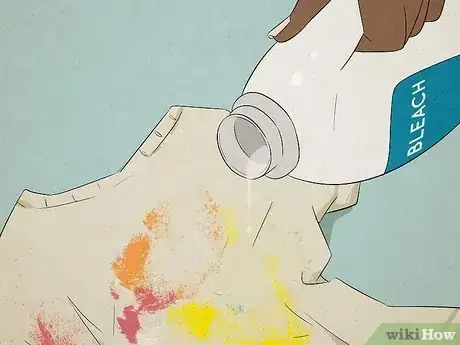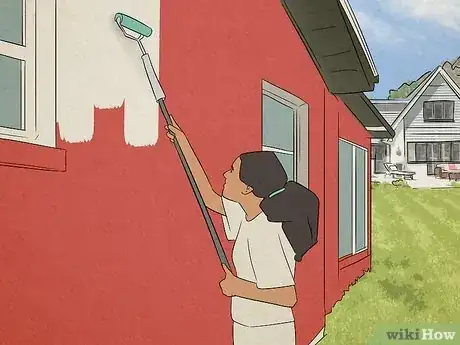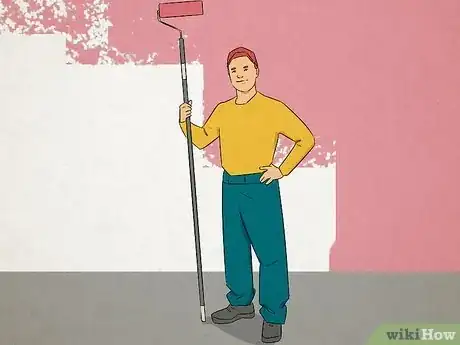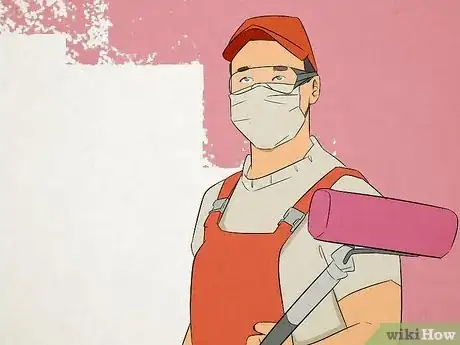This article was co-authored by wikiHow staff writer, Dan Hickey. Dan Hickey is a Writer and Humorist based in Chicago, Illinois. He has published pieces on a variety of online satire sites and has been a member of the wikiHow team since 2022. A former teaching artist at a community music school, Dan enjoys helping people learn new skills they never thought they could master. He graduated with a BM in Clarinet Performance from DePauw University in 2015 and an MM from DePaul University in 2017.
There are 8 references cited in this article, which can be found at the bottom of the page.
Learn more...
If you’ve ever wondered why painters traditionally wear all white for such a messy job, you’re not alone. It might not make sense when you first think about it, but there are actually a number of surprising historical and practical reasons for an all-white uniform. In this article, we’ll walk you through the unique traditions of “painter’s whites” plus show you what to wear for your own DIY paint projects. Good news—you probably already have what you need laying around!
Things You Should Know
- The all-white painter’s uniform represented union membership in the 20th century.
- White fabric is easy to bleach, keeps workers cool in sunlight, and is cheap to manufacture and purchase.
- Many painters today wear white work overalls with a long-sleeved shirt or t-shirt underneath. This outfit is known as “painter’s whites.”
- Wear any colored clothing you can move in and don’t mind getting messy for DIY projects. Wear sturdy shoes, a hat, goggles, and a mask for maximum safety.
Steps
Historical Reasons for All White
-
1Wearing white meant you were in the painters’ union in the 20th century. Before the 1900s, painters wore all kinds of clothing and colors when they worked depending on what they had on hand. As unions started to grow in the mid-19th century and early 20th century, painters who belonged to the International Union of Painters and Allied Trades (IUPAT) began wearing white to distinguish themselves from non-union painters.[1] X Research source
- The trend of wearing a certain color to show you belonged to a union wasn’t just for painters. Workers in other fields adopted their own color codes, too.
-
2White looks clean and professional. In the 19th and 20th centuries, a crisp and spotless painter’s uniform let customers know that they hired an experienced professional who didn’t splatter or drip any paint on the job.[2] X Research source It was also union protocol to keep uniforms as clean as possible. Nowadays, many painters wear splatters and drips as badges of honor to show they’re experienced.[3] X Research source
- Some white uniforms still signal professionalism or luxury to customers today. Picture a gourmet chef’s hat and apron or a doctor’s lab coat.
Advertisement -
3White doesn’t show drips from primer, caulk, and other white materials. In the 17th century, painters made their own paint with white powders and oxides that tended to make a mess, so they adopted white clothes to look cleaner. Early ship painters used lots of white paint, and some would even make clothes out of white canvas ship sails to disguise the mess.[4] X Research source
- Today, painters still deal with primers, white paint, caulk, drywall, and other messy white materials.[5] X Research source
- White is one of the most popular paint colors today, so an all-white uniform is just as practical now as it was centuries ago.
-
4Wearing all white is simply a tradition. Lots of painters today wear white and aren’t aware of the interesting history behind it—they just know that’s what you traditionally wear when you paint. Some modern painters go against the tradition and wear whatever clothes they have that they don’t mind getting paint on.[6] X Research source
- Whether a painter wears white or not can depend on what they have available or whether they think the tradition is outdated or not.
Practical Reasons for All White
-
1A white uniform is a warning that wet paint is nearby. The all-white uniform is so recognizable nowadays that most passersby know they might get some wet paint on their hands or clothes if they don’t tread carefully. The signal also serves to protect the painters’ work—if someone touches a wet wall (“spoiling”), then the painter will have to go over the spot again which wastes time, money, and effort.[7] X Research source
-
2White can be easily bleached to keep it looking clean. Painters don’t have to worry about the color fading from their work clothes when they wash them since they’re meant to be white anyway. This makes it convenient to remove stains or paint with bleach and keep your clothes looking like new.[8] X Research source
-
3White reflects sunlight and keeps workers cool while painting outside. A painter can get awfully hot when they’re painting the outside of a house on a summer afternoon when the sun is blazing. White clothing helps keep them a little cooler than a darker colored uniform would since it reflects light and doesn’t trap heat well.[9] X Research source
- If you’ve got painters outside, offer them a glass of cold water or ask if they want to take a quick break inside to avoid getting overheated.
-
4White clothes are cheap to manufacture and widely available. Many clothing items start out as white before they’re dyed, making them slightly more expensive to produce and buy than plain white gear. Since painters get their work clothes dirty and need to replace them often, they opt for white because it’s generally less expensive.[10] X Research source
- It’s also easy to find a wide variety of different clothing items offered in white compared to other colors.
What do modern painters wear?
-
Painters wear white overalls and a long-sleeved white shirt or t-shirt. The outfit is called “painter’s whites” and isn’t standard across the industry—many painters supply their own white clothes and work in what’s comfortable. Some ditch the traditional overalls and wear white pants made of canvas, denim, or other durable fabrics.[11] X Research source
- Painter’s overalls are popular because of their loose fit that allows for a full range of motion in the arms, torso, and legs.
- Not all painters wear white. Many wear cheap, comfortable work clothes regardless of what color they are.
What should I wear for DIY paint jobs?
-
1Wear any clothes you don't mind getting messy. Save yourself another expense and wear old, comfortable clothing (in any color) you already have. DIY projects are usually shorter and more casual than professional ones, so you don’t have to worry as much about things like reflecting the sun for long periods or being recognized as a professional painter.[12] X Research source
- If you’re mainly painting for home maintenance, you won’t have to paint very often. This means any clothes you buy will sit in a drawer for a long time.
-
2Choose long sleeves and pants that fit well and aren’t too baggy. Opt for clothes that stay somewhat close to your skin so you don’t accidentally drag a sleeve into paint and make a mess. Make sure they’re not so tight that your range of motion is restricted, though. Check that you can still move your arms, bend and twist your torso, and sit or squat comfortably.[13] X Research source
- Go for clothes made of lightweight and breathable fabrics like cotton or polyester. They're comfortable, durable, and stretchier than canvas or denim.
-
3Wear a hat or bandana to keep paint out of your hair. Choose an old ball cap or something you already have laying around to keep paint, paint chips, dust, or other debris off your head. The headgear will also hold long hair back and keep it out of your face, too.[14] X Research source
- If you have longer hair, tie it back before you start painting (unless you want to try using a ponytail as a paint brush!).
-
4Put on comfortable, old shoes with good traction. Wear a pair of gym shoes or sneakers that you can move comfortably in and that you don’t mind getting dirty. Make sure the soles still have a good grip, especially if you’ll be climbing a ladder at any point. The traction will keep you steady on a ladder rung or on a slick patch of floor while you paint.[15] X Trustworthy Source Consumer Reports Nonprofit organization dedicated to consumer advocacy and product testing Go to source
- Consider wearing shoe covers or plastic bags over your shoes to prevent tracking paint or dust to other areas.[16] X Trustworthy Source Consumer Reports Nonprofit organization dedicated to consumer advocacy and product testing Go to source
-
5Get a pair of goggles to keep paint flecks and debris out of your eyes. They may not look fashionable, but wear safety goggles to block dust, dirt, paint chips, and other painting-related foreign objects (especially if you’re painting a ceiling and have to look upward). If something does get in your eye, try to remove it as fast as possible and flush your eye with eyewash or a sterile saline solution.[17] X Research source
- See a doctor if you cannot remove the object, think it’s embedded in your eye, have abnormal vision, or have pain or redness after it’s removed.
-
6Wear a face mask or respirator to shield your nose and mouth. Put on a simple paint mask to keep paint splatter, dust, and other physical debris out of your nose, mouth, and lungs. If you’re spray painting or using any toxic chemicals, wear a respirator to filter out minute paint particles and harmful fumes.[18] X Research source
Other wikiHows

 How to Relieve & Prevent Headaches & Migraines Fast
How to Relieve & Prevent Headaches & Migraines Fast
 Best Ways to Unclog a Toilet
Best Ways to Unclog a Toilet

 How to Take a Screenshot on a Windows PC: 8 Simple Tricks
How to Take a Screenshot on a Windows PC: 8 Simple Tricks

 How to Take Care of Potted Orchids
How to Take Care of Potted Orchids

References
- ↑ https://talkradionews.com/why-do-painters-wear-white/
- ↑ https://homeguidecorner.com/why-do-painters-wear-white/
- ↑ https://bestlifeonline.com/why-painters-wear-white/
- ↑ https://painters.edu.au/Articles/why-do-painters-wear-white.htm
- ↑ https://homegardenguides.com/painting/why-do-painters-wear-white/
- ↑ https://threadcurve.com/why-do-painters-wear-overalls/
- ↑ https://talkradionews.com/why-do-painters-wear-white/
- ↑ https://homeguidecorner.com/why-do-painters-wear-white/
- ↑ https://bestlifeonline.com/why-painters-wear-white/
- ↑ https://talkradionews.com/why-do-painters-wear-white/
- ↑ https://threadcurve.com/why-do-painters-wear-overalls/
- ↑ https://homegardenguides.com/painting/why-do-painters-wear-white/
- ↑ https://homegardenguides.com/painting/why-do-painters-wear-white/
- ↑ https://www.house-painting-info.com/articles/what-to-wear-while-painting/
- ↑ https://www.consumerreports.org/painting/repainting-home-exterior-lead-paint/
- ↑ https://www.consumerreports.org/painting/repainting-home-exterior-lead-paint/
- ↑ https://www.house-painting-info.com/articles/what-to-wear-while-painting/
- ↑ https://homegardenguides.com/painting/why-do-painters-wear-white/
About This Article




























































